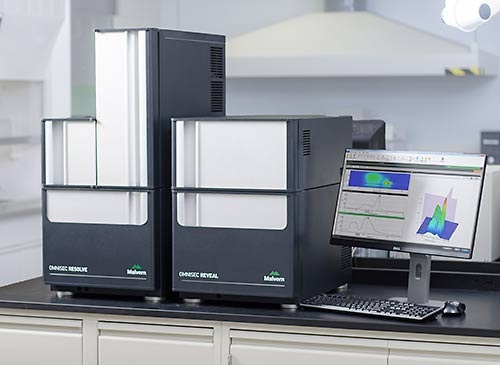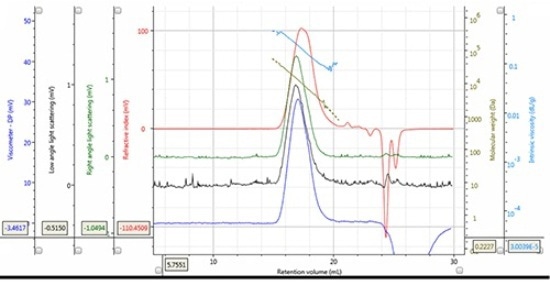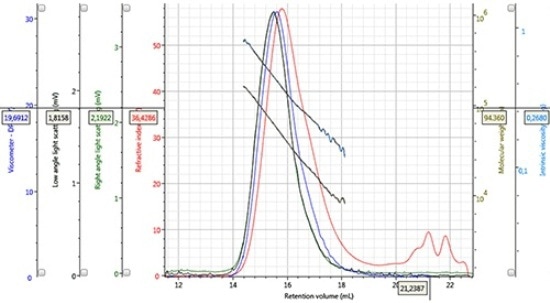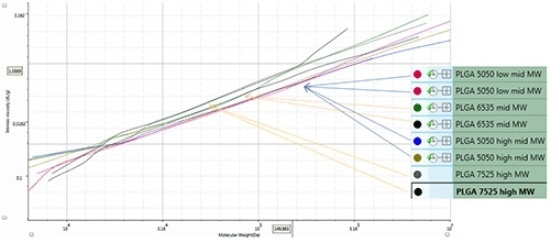PLA and PLGA are “green” polymers as they are based on monomers derived from renewable sources. These biocompatible and biodegradable polymers are used in a myriad of applications including: farming materials, food packaging, implants and biomedical devices.
With a low melt processing temperature, PLA is also suitable for 3D printing applications. Advanced GPC/SEC analysis can be used for sample monitoring during material synthesis, component production as well as in degradation analyzes.
Detailed molecular mass average data can be obtained with advanced multi-detector GPC/SEC. In conjunction with viscometer, light scattering and refractive index detectors, advanced multi-detector GPC/SEC can reveal about the structure and solution properties.
This article discusses the analysis of different PLA and PLGA polymer samples using the OMNISEC GPC/SEC system from Malvern Panalytical that features the aforementioned detectors.
Instrumentation and Experimental Procedure
The experimental setup involved two LT5000L columns for separation. Tetrahydrofuran (THF) served as eluent in the chromatographic system, and as solvent in the preparation of sample solutions of concentrations of 1-5 mg/mL. The detectors, columns and autosampler were maintained at a temperature of 30°C.
The OMNISEC GPC/SEC System
The OMNISEC GPC/SEC system comprises two modules, namely OMNISEC RESOLVE and OMNISEC REVEAL (Figure 1). OMNISEC RESOLVE is a chromatography module featuring temperature controlled column compartment, temperature controlled autosampler, degasser and pump.
OMNISEC REVEAL is a temperature controlled detector module consisting of up to four detectors such as viscometer, light scattering, UV/VIS absorbance, and refractive index detectors.

Figure 1. The OMNISEC SYSTEM, with RESOLVE module on the left and REVEAL module on the right.
OMNISEC RESOLVE and OMNISEC REVEAL complement each other, making the OMNISEC GPC/SEC system as a comprehensive, powerful, and user-friendly system. Malvern Panalytical also offers OMNISEC REVEAL as an add-on detector module for other existing chromatography solutions.
Experimental Results
A typical chromatogram for a PLA sample analyzed with the OMNISEC system is shown in Figure 2, plotting derived molecular mass and intrinsic viscosity over the retention volume. Although THF can dissolve most of the PLA and PLGA samples, the refractive index increment (dn/dc) for this sample/solvent combination has a low value of roughly 0.045-0.051 mL/g.

Figure 2. Chromatogram and derived data of PLA Mw = 12,188 g/mol, Mn = 7,487 g/mol, concentration 5.149 mg/mL, 100 µL injection volume.
The dn/dc value reveals the sensitivity of both light scattering and refractive index detectors. The low signal issue of PLA and PLGA can be overcome by using acetone as an alternative eluent.
However, the GPC/SEC system cannot be used for other applications when acetone is used s the eluent. Hence, THF is the solvent of choice for PLA and PLGA characterization, which can be performed with the OMNISEC REVEAL module owing to its better detector sensitivity.
The outstanding data quality for the detector signals as well as the derived data obtained from the OMNISEC system can be observed in Figures 2 and 3 for PLA and PLGA, respectively.

Figure 3. Chromatogram and derived data of PLGA 50:50, Mw = 44,628 g/mol, Mn = 26,727 g/mol, concentration 2.132 mg/mL, 100 µL injection volume.
Molecular Structure
Intrinsic viscosities across the peak can be determined using the sensitive viscometer featured in the OMNISEC REVEAL module. Differences in the sample structures can be observed from the Mark-Houwink-plot (log [η] vs log MW). Composition differences of PLGA samples can also be revealed due to the slight difference in the coil density caused by the compositional changes.
The Mark-Houwink-plots for duplicate injections of PLGA samples of different compositions of lactide:glycolide are depicted in Figure 4.
The highest curve represents the samples with 75:25 composition of lactide:glycolide, whereas the middle curve represents the samples containing a lactide:glycolide ratio of 65:35 and the lowest curve represents the samples with a 50:50 lactide:glycolide composition.

Figure 4. Mark-Houwink-plot for PLGA samples.
Reliable Data
The new autosampler featured in the OMNISEC RESOLVE module is specifically designed to deal with viscous sample solutions for GPC/SEC analyzes. Reliable measurements can be obtained from reliable injections.
A PLGA sample containing 50% lactic acid content with a concentration of 2.132mg/mL was used for 10 repeat injections of 100µL. The measured parameters along with their corresponding relative standard deviation are summarized in the following table:
| Parameter |
Average value |
unit |
RSD / % |
| Mn |
26,102 |
g/mol |
2.32 |
| Mw |
44,722 |
g/mol |
0.37 |
| Mz |
67,009 |
g/mol |
1.22 |
| [η]w |
0.36 |
dL/g |
1.37 |
| Rh,w |
6.07 |
nm |
0.50 |
A relative standard deviation of 0.53% was revealed by the recovery for those 10 adjacent injections, demonstrating the outstanding repeatability of the data acquired by the OMNISEC GPC/SEC system.
Conclusion
The results demonstrate the user-friendliness and reliability of the OMNISEC GPC/SEC system to determine the molecular structure, hydrodynamic radius, intrinsic viscosity and molecular mass. Different compositions of PLGA can be clearly differentiated by determining the different properties exhibited by the samples in solution.
It has been demonstrated that the combination of a reliable chromatographic technique and a reliable chromatographic system featuring high performance detectors can only produce reproducible results.
Since factors such as composition and molecular weight of PLGA greatly affect its final properties, performing the aforementioned measurements will be helpful in gaining new insights into and controlling those final properties.

This information has been sourced, reviewed and adapted from materials provided by Malvern Panalytical.
For more information on this source, please visit Malvern Panalytical.